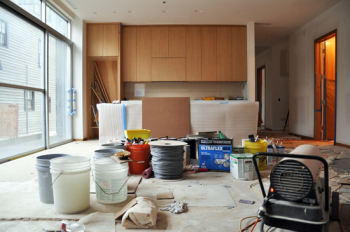Blog
Uncovered: 5 options for protecting your floors
18 September 2015

You know what building sites are like, right?
Tools get dropped, paint and plaster gets spilled, boots tramp in debris, ladders get dragged - and it’s all in a day’s work.
Without adequate protection a floor (new or existing) can literally take a hammering.
Any repair work takes time and costs money. Worse still, it can seriously strain your relationship with your customer.
So how do you protect the floors?
5 options for protecting floors while you work
Fabric drop cloths
Often people use old sheets or curtains to protect floors (fabric drop cloths).
Fabric drop cloths are economic - usually you can pick them up for next to nothing. Also re-purposing an old sheet is good way to give it a second life. But drop cloths are serious trip hazards (they get bunched up as you move over them) and provide limited protection for your floors.
- Fiddly to lay out and flatten
- Spilt paint seeps right through them (before you get a chance to mop up)
- Drop cloths don’t provide any impact protection (against dropped tools or materials)
- Bunched up cloths are a trip hazard
On the plus side fabric drop cloths are easy to shake out and fold up after you’ve finished the job and can be re-used. You can also use them to cover furniture too.
Plastic sheets
Plastic sheets are a more sophisticated version of a fabric drop cloths. They protect the floors from spills, but have a number of shortfalls when it comes to floor protection. They can also cause problems with new floor curing.
- The plastic holds in moisture and can ‘sweat’ which may damage the floor
- Grout and other coatings take longer to dry with plastic over them (and may not cure completely)
- Plastic sheets don’t provide impact protection
- The plastic can be slippery to walk on and tends to creep and create a trip hazard
Plastic sheets are prone to tearing but can usually be used more than once. They can be quite bulky to fold and are difficult to layout and flatten again. But they do provide more protection than fabric.
Left overs
A patchwork of old pieces of carpet or cardboard or other material is sometimes used. The main problem here is inconsistent coverage and gaps (so not everywhere is protected) and also tripping hazards. This technique is cheap but looks it! Probably not the way to go if you want to look professional.
Stick-on plastic
Stick-on plastic is another option. It’s quick and easy to roll out and stick down. Because it is stuck down it eliminates any creep and bunching, so no trip hazards. Common issues with stick-on products are:
- The plastic holds in moisture and can ‘sweat’ which may damage the floor
- Grout and other coatings take longer to dry with plastic over them (and may not cure completely)
- No impact protection
- Prone to rips and tears (which can cause trip hazards as well as expose the floor)
- A residue can be left on the floor afterwards
Because it is stuck down, stick-on protection can only be used once.
Temporary Floor Protection
Products such as Ovaboard are specially designed to protect floors while work is being carried out. While these products are slightly more expensive to purchase upfront, they save you money in the long term. They offer a much higher level of protection and convenience.
- Spill resistant - paint and liquids won’t seep through
- Impact resistant
- Non-slip and durable working surface – no tripping hazards
- Allows natural curing – vapour permeable so your floors won’t sweat
Ovaboard rolls out easily and is quick to lay down flat. It can be rolled back up and used many times. It’s tough and won’t rip or tear. Ovaboard is made out of 100% recycled material and is totally recyclable
Want to protect the floor and your reputation?
Ovaboard offers the best level of protection from liquid spills and impact drops, it’s easy to handle and safe to work on. Think of it as providing insurance and efficiency - you won’t damage the floor and you don’t have to take off your boots every time you walk through the door.
Contact us or find your local supplier.

